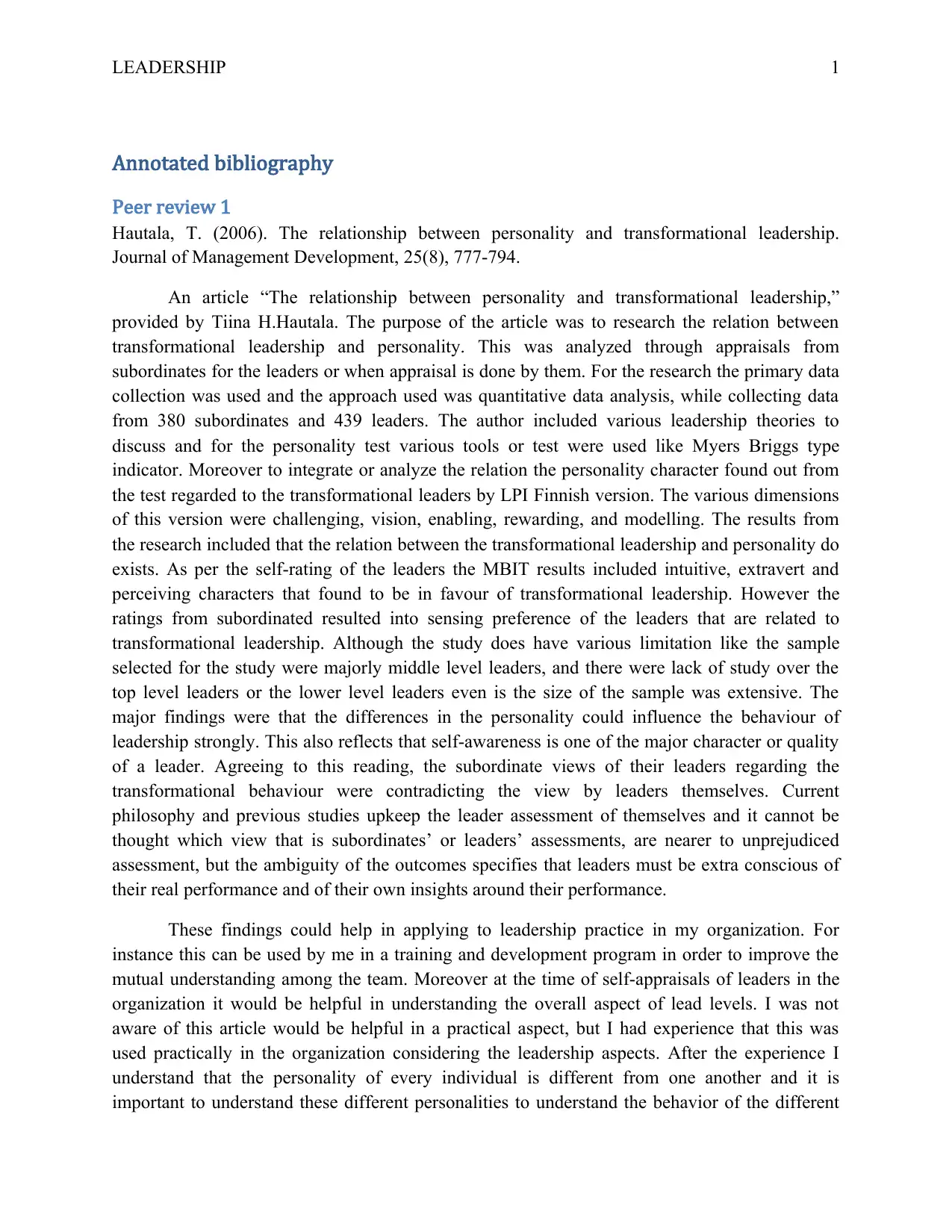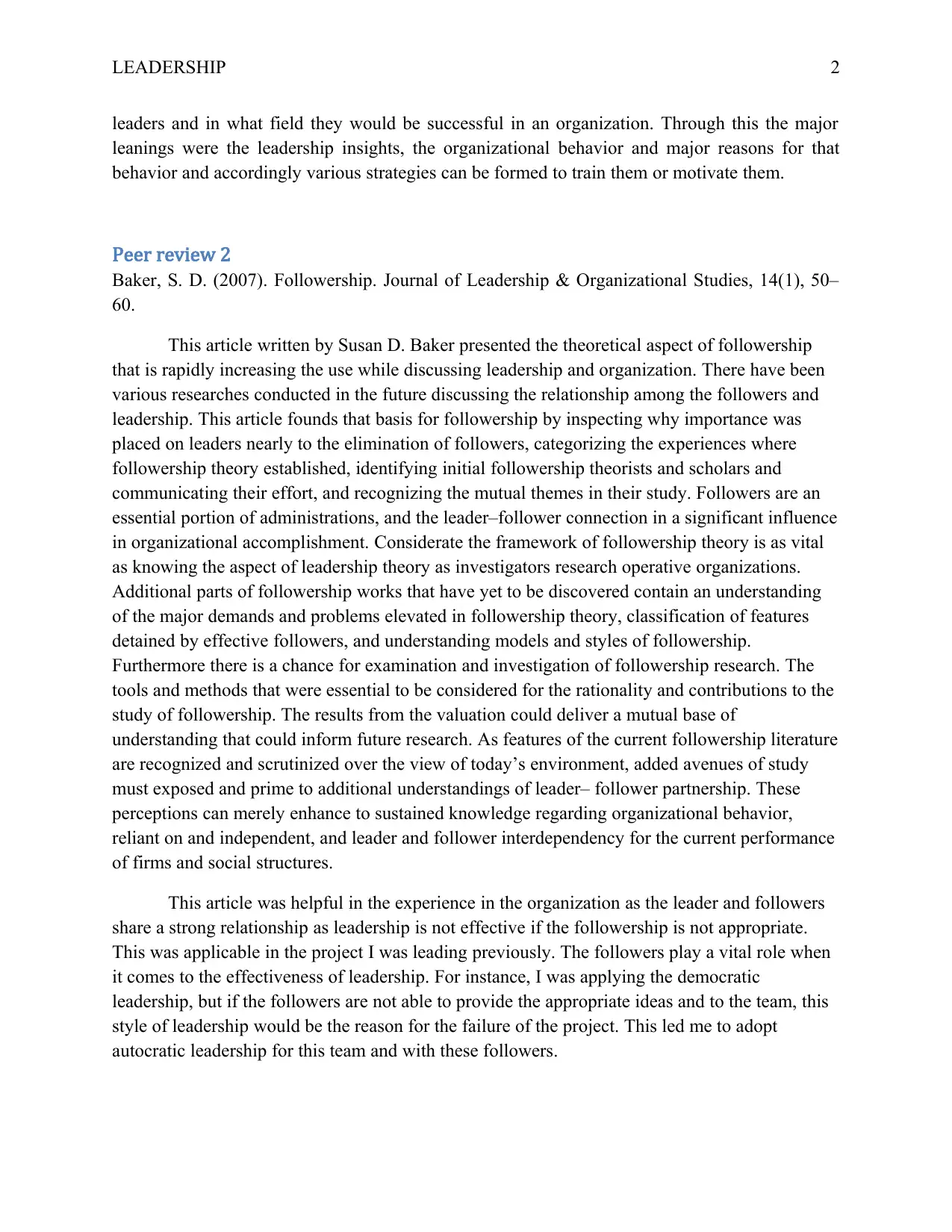ZBUS8201 - Leadership: Annotated Bibliography of Research & Reflection
VerifiedAdded on 2023/04/17
|3
|938
|53
Annotated Bibliography
AI Summary
This assignment presents an annotated bibliography featuring two peer-reviewed journal articles focused on leadership. The first article explores the relationship between personality and transformational leadership, utilizing quantitative data analysis and various personality assessment tools. The findings suggest a correlation between personality traits and leadership behavior, highlighting the importance of self-awareness for leaders. The second article examines the theoretical aspect of followership, emphasizing the crucial role of followers in organizational success and the interdependence between leaders and followers. Both annotations include reflections on the application of these findings to leadership practices within an organizational context, demonstrating how understanding these concepts can improve team dynamics and leadership effectiveness. Desklib is a valuable resource for students seeking similar solved assignments and study materials.

RunningHead: 0
LEADERSHIP
LEADERSHIP
2019
Student name
3/24/2019
LEADERSHIP
LEADERSHIP
2019
Student name
3/24/2019
Paraphrase This Document
Need a fresh take? Get an instant paraphrase of this document with our AI Paraphraser

LEADERSHIP 1
Annotated bibliography
Peer review 1
Hautala, T. (2006). The relationship between personality and transformational leadership.
Journal of Management Development, 25(8), 777-794.
An article “The relationship between personality and transformational leadership,”
provided by Tiina H.Hautala. The purpose of the article was to research the relation between
transformational leadership and personality. This was analyzed through appraisals from
subordinates for the leaders or when appraisal is done by them. For the research the primary data
collection was used and the approach used was quantitative data analysis, while collecting data
from 380 subordinates and 439 leaders. The author included various leadership theories to
discuss and for the personality test various tools or test were used like Myers Briggs type
indicator. Moreover to integrate or analyze the relation the personality character found out from
the test regarded to the transformational leaders by LPI Finnish version. The various dimensions
of this version were challenging, vision, enabling, rewarding, and modelling. The results from
the research included that the relation between the transformational leadership and personality do
exists. As per the self-rating of the leaders the MBIT results included intuitive, extravert and
perceiving characters that found to be in favour of transformational leadership. However the
ratings from subordinated resulted into sensing preference of the leaders that are related to
transformational leadership. Although the study does have various limitation like the sample
selected for the study were majorly middle level leaders, and there were lack of study over the
top level leaders or the lower level leaders even is the size of the sample was extensive. The
major findings were that the differences in the personality could influence the behaviour of
leadership strongly. This also reflects that self-awareness is one of the major character or quality
of a leader. Agreeing to this reading, the subordinate views of their leaders regarding the
transformational behaviour were contradicting the view by leaders themselves. Current
philosophy and previous studies upkeep the leader assessment of themselves and it cannot be
thought which view that is subordinates’ or leaders’ assessments, are nearer to unprejudiced
assessment, but the ambiguity of the outcomes specifies that leaders must be extra conscious of
their real performance and of their own insights around their performance.
These findings could help in applying to leadership practice in my organization. For
instance this can be used by me in a training and development program in order to improve the
mutual understanding among the team. Moreover at the time of self-appraisals of leaders in the
organization it would be helpful in understanding the overall aspect of lead levels. I was not
aware of this article would be helpful in a practical aspect, but I had experience that this was
used practically in the organization considering the leadership aspects. After the experience I
understand that the personality of every individual is different from one another and it is
important to understand these different personalities to understand the behavior of the different
Annotated bibliography
Peer review 1
Hautala, T. (2006). The relationship between personality and transformational leadership.
Journal of Management Development, 25(8), 777-794.
An article “The relationship between personality and transformational leadership,”
provided by Tiina H.Hautala. The purpose of the article was to research the relation between
transformational leadership and personality. This was analyzed through appraisals from
subordinates for the leaders or when appraisal is done by them. For the research the primary data
collection was used and the approach used was quantitative data analysis, while collecting data
from 380 subordinates and 439 leaders. The author included various leadership theories to
discuss and for the personality test various tools or test were used like Myers Briggs type
indicator. Moreover to integrate or analyze the relation the personality character found out from
the test regarded to the transformational leaders by LPI Finnish version. The various dimensions
of this version were challenging, vision, enabling, rewarding, and modelling. The results from
the research included that the relation between the transformational leadership and personality do
exists. As per the self-rating of the leaders the MBIT results included intuitive, extravert and
perceiving characters that found to be in favour of transformational leadership. However the
ratings from subordinated resulted into sensing preference of the leaders that are related to
transformational leadership. Although the study does have various limitation like the sample
selected for the study were majorly middle level leaders, and there were lack of study over the
top level leaders or the lower level leaders even is the size of the sample was extensive. The
major findings were that the differences in the personality could influence the behaviour of
leadership strongly. This also reflects that self-awareness is one of the major character or quality
of a leader. Agreeing to this reading, the subordinate views of their leaders regarding the
transformational behaviour were contradicting the view by leaders themselves. Current
philosophy and previous studies upkeep the leader assessment of themselves and it cannot be
thought which view that is subordinates’ or leaders’ assessments, are nearer to unprejudiced
assessment, but the ambiguity of the outcomes specifies that leaders must be extra conscious of
their real performance and of their own insights around their performance.
These findings could help in applying to leadership practice in my organization. For
instance this can be used by me in a training and development program in order to improve the
mutual understanding among the team. Moreover at the time of self-appraisals of leaders in the
organization it would be helpful in understanding the overall aspect of lead levels. I was not
aware of this article would be helpful in a practical aspect, but I had experience that this was
used practically in the organization considering the leadership aspects. After the experience I
understand that the personality of every individual is different from one another and it is
important to understand these different personalities to understand the behavior of the different

LEADERSHIP 2
leaders and in what field they would be successful in an organization. Through this the major
leanings were the leadership insights, the organizational behavior and major reasons for that
behavior and accordingly various strategies can be formed to train them or motivate them.
Peer review 2
Baker, S. D. (2007). Followership. Journal of Leadership & Organizational Studies, 14(1), 50–
60.
This article written by Susan D. Baker presented the theoretical aspect of followership
that is rapidly increasing the use while discussing leadership and organization. There have been
various researches conducted in the future discussing the relationship among the followers and
leadership. This article founds that basis for followership by inspecting why importance was
placed on leaders nearly to the elimination of followers, categorizing the experiences where
followership theory established, identifying initial followership theorists and scholars and
communicating their effort, and recognizing the mutual themes in their study. Followers are an
essential portion of administrations, and the leader–follower connection in a significant influence
in organizational accomplishment. Considerate the framework of followership theory is as vital
as knowing the aspect of leadership theory as investigators research operative organizations.
Additional parts of followership works that have yet to be discovered contain an understanding
of the major demands and problems elevated in followership theory, classification of features
detained by effective followers, and understanding models and styles of followership.
Furthermore there is a chance for examination and investigation of followership research. The
tools and methods that were essential to be considered for the rationality and contributions to the
study of followership. The results from the valuation could deliver a mutual base of
understanding that could inform future research. As features of the current followership literature
are recognized and scrutinized over the view of today’s environment, added avenues of study
must exposed and prime to additional understandings of leader– follower partnership. These
perceptions can merely enhance to sustained knowledge regarding organizational behavior,
reliant on and independent, and leader and follower interdependency for the current performance
of firms and social structures.
This article was helpful in the experience in the organization as the leader and followers
share a strong relationship as leadership is not effective if the followership is not appropriate.
This was applicable in the project I was leading previously. The followers play a vital role when
it comes to the effectiveness of leadership. For instance, I was applying the democratic
leadership, but if the followers are not able to provide the appropriate ideas and to the team, this
style of leadership would be the reason for the failure of the project. This led me to adopt
autocratic leadership for this team and with these followers.
leaders and in what field they would be successful in an organization. Through this the major
leanings were the leadership insights, the organizational behavior and major reasons for that
behavior and accordingly various strategies can be formed to train them or motivate them.
Peer review 2
Baker, S. D. (2007). Followership. Journal of Leadership & Organizational Studies, 14(1), 50–
60.
This article written by Susan D. Baker presented the theoretical aspect of followership
that is rapidly increasing the use while discussing leadership and organization. There have been
various researches conducted in the future discussing the relationship among the followers and
leadership. This article founds that basis for followership by inspecting why importance was
placed on leaders nearly to the elimination of followers, categorizing the experiences where
followership theory established, identifying initial followership theorists and scholars and
communicating their effort, and recognizing the mutual themes in their study. Followers are an
essential portion of administrations, and the leader–follower connection in a significant influence
in organizational accomplishment. Considerate the framework of followership theory is as vital
as knowing the aspect of leadership theory as investigators research operative organizations.
Additional parts of followership works that have yet to be discovered contain an understanding
of the major demands and problems elevated in followership theory, classification of features
detained by effective followers, and understanding models and styles of followership.
Furthermore there is a chance for examination and investigation of followership research. The
tools and methods that were essential to be considered for the rationality and contributions to the
study of followership. The results from the valuation could deliver a mutual base of
understanding that could inform future research. As features of the current followership literature
are recognized and scrutinized over the view of today’s environment, added avenues of study
must exposed and prime to additional understandings of leader– follower partnership. These
perceptions can merely enhance to sustained knowledge regarding organizational behavior,
reliant on and independent, and leader and follower interdependency for the current performance
of firms and social structures.
This article was helpful in the experience in the organization as the leader and followers
share a strong relationship as leadership is not effective if the followership is not appropriate.
This was applicable in the project I was leading previously. The followers play a vital role when
it comes to the effectiveness of leadership. For instance, I was applying the democratic
leadership, but if the followers are not able to provide the appropriate ideas and to the team, this
style of leadership would be the reason for the failure of the project. This led me to adopt
autocratic leadership for this team and with these followers.
⊘ This is a preview!⊘
Do you want full access?
Subscribe today to unlock all pages.

Trusted by 1+ million students worldwide
1 out of 3
Related Documents
Your All-in-One AI-Powered Toolkit for Academic Success.
+13062052269
info@desklib.com
Available 24*7 on WhatsApp / Email
![[object Object]](/_next/static/media/star-bottom.7253800d.svg)
Unlock your academic potential
Copyright © 2020–2025 A2Z Services. All Rights Reserved. Developed and managed by ZUCOL.





